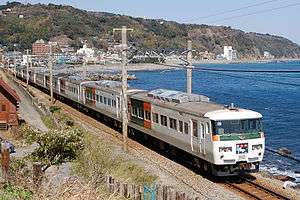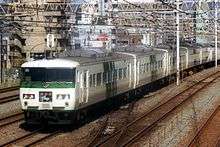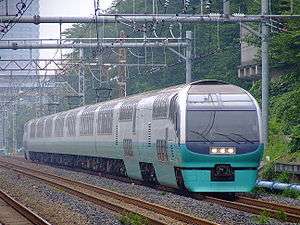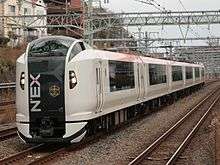Odoriko
 185 series Odoriko, March 2007 | |
| Overview | |
|---|---|
| Service type | Limited express |
| Locale | Tokyo, Kanagawa Prefecture, Shizuoka Prefecture |
| First service |
1 October 1981 (Odoriko) 28 April 1990 (Super View Odoriko) |
| Current operator(s) |
East Japan Railway Company (JR East) Central Japan Railway Company (JR Central) Izukyu Corporation Izuhakone Railway |
| Former operator(s) | JNR |
| Route | |
| Start | Tokyo or Ikebukuro |
| End | Izukyu-Shimoda or Shuzenji |
| Line(s) used | Tōkaidō Main Line, Itō Line, Izu Kyūkō Line, Sunzu Line |
| On-board services | |
| Class(es) | Standard + Green |
| Technical | |
| Rolling stock |
185 series EMU (Odoriko) 251 series EMU (Super View Odoriko) |
| Track gauge | 1,067 mm (3 ft 6 in) |
| Electrification | 1,500 V DC overhead |
| Operating speed | 120 km/h (75 mph) (Super View Odoriko) |
The Odoriko (踊り子) is a limited express train service in Japan operated by East Japan Railway Company (JR East), Central Japan Railway Company (JR Central), Izukyu Corporation and Izuhakone Railway, which runs between Tokyo and Izukyū-Shimoda or Shuzenji in Shizuoka Prefecture.
Summary
The Odoriko started service from October 1981, with the then-new 185 series rolling stock, replacing the earlier Amagi limited express (ran by 183 series) and the Izu express (ran by 153 series). After that, the Super View Odoriko also started service from April 1990, with the 251 series rolling stock.
Regular services
Odoriko
3 services operate back and forth everyday between Tokyo and Izukyu-Shimoda. 2 of which are coupled with services that go to Shuzenji (decoupled at Atami). Vending services are available between Tokyo and Ito, but aren't available aboard temporary services. Aside from that, there are temporary services originating from Shinjuku or Ikebukuro. Also, with the Ueno-Tokyo Line opening on March 2015, there are temporary services originating at Abiko, via the Joban Line[1]; and also at Omiya, via the Ueno-Tokyo Line.[2]
Stations served
- Tokyo ー Izukyu-Shimoda:
- Tokyo ー Shinagawa ー Kawasaki ー Yokohama ー Ofuna ー Odawara ー Yugawara ー Atami ー Ajiro ー Ito ー Izu-Kogen ー Izu-Atagawa ー Izu-Inatori ー Kawazu ー Izukyu-Shimoda
- Atami ー Shuzenji:
- (Coupled, and continue on towards Tokyo) ー Atami ー Mishima ー Mishima-Tamachi ー Daiba ー Izu-Nagaoka ー Ohito ー Shuzenji
Temporary services
- Ikebukuro ー Yokohama:
- Ikebukuro ー Shinjuku ー Musashi-Kosugi ー Yokohama ー (Continue on towards Izukyu-Shimoda)
- Abiko ー Tokyo:
- Abiko ー Kashiwa ー Matsudo ー Kita-Senju ー Ueno ー Tokyo ー (Continue on towards Izukyu-Shimoda)
- Omiya ー Tokyo:
- Omiya ー Urawa ー Akabane ー Ueno ー Tokyo ー (Continue on towards Izukyu-Shimoda)

Formation
Services are operated by 5, 7, 5+7, 10 and 10+5-car 185 series EMUs. The 15 car formation makes the Odoriko the longest Limited Express train running in Japan (excluding shinkansen trains).[3] They are formed as follows, with car 1 at the Izukyū-Shimoda/Shuzenji end.
| Car No. | 1 | 2 | 3 | 4 | 5 | 6 | 7 | 11 | 12 | 13 | 14 | 15 |
|---|---|---|---|---|---|---|---|---|---|---|---|---|
| Accommodation | Reserved | Reserved | Reserved | Green | Reserved | Non-reserved | Non-reserved | Non-reserved | Non-reserved | Reserved | Reserved | Reserved |
| Set | Basic set | Additional set | ||||||||||
| Car No. | 1 | 2 | 3 | 4 | 5 | 6 | 7 | 8 | 9 | 10 | 11 | 12 | 13 | 14 | 15 |
|---|---|---|---|---|---|---|---|---|---|---|---|---|---|---|---|
| Accommodation | Reserved | Reserved | Reserved | Green | Green | Reserved | Reserved | Reserved | Non-reserved | Non-reserved | Non-reserved | Non-reserved | Reserved | Reserved | Reserved |
| Set | Basic set | Additional set | |||||||||||||
Super View Odoriko
The Super View Odoriko (スーパービュー踊り子) is a deluxe version of the Odoriko introduced from 28 April 1990.[4] It uses 251 series 10-car EMUs and runs between Tokyo or Ikebukuro and Izukyū-Shimoda.[3] The service was originally scheduled to commence from the start of the revised timetable on 10 March 1990, but rolling stock delivery delays meant that services were substituted by regular Odoriko services using 185 series EMUs.[4]
On weekdays, 1 train operate from Shinjuku to Izukyu-Shimoda, 2 trains operate back and forth between Tokyo and Izukyu-Shimoda, and 1 train operate from Izukyu-Shimoda to Ikebukuro each day.
On weekends, the Shinjuku-originating train changes originating station to Ikebukuro. Aside from that, services from Shinjuku to Izukyu-Shimoda and from Izukyu-Shimoda to Tokyo operate once a day. Moreover, during busy seasons, there are numerous extra services, with 1 extended service between Omiya and Izukyu-Shimoda, which runs along the Shonan-Shinjuku Line from Omiya to Yokohama; 2 trains from Tokyo to Izukyu-Shimoda, with only 1 returning to Tokyo; and 1 train from Izukyu-Shimoda to Shinjuku.
Stations served
Stations in brackets means that some services would stop.
- Tokyo ー Izukyu-Shimoda:
- Tokyo ー (Shinagawa) ー Yokohama ー (Odawara) ー (Yugawara) ー Atami ー (Ajiro) ー Ito ー Izu-Kogen ー Izu-Atagawa ー Izu-Inatori ー Kawazu ー Izukyu-Shimoda
- Only Super View Odoriko No. 5 and No.8 stop at Shinagawa.
- Only Super View Odoriko No. 2 and No.11 stop at Odawara, Yugawara and Ajiro.
- Ikebukuro ー Yokohama:
- Ikebukuro ー Shinjuku ー Musashi-Kosugi ー Yokohama ー (Continue on towards Izukyu-Shimoda)
Temporary services

Formation
Super View Odoriko trains are operated with 251 series trains, with cars 1, 2 and 10 being double decker carriages. Trains are formed as follows, with car 1 at the Izukyū-Shimoda end, and car 10 at the Tokyo and Shinjuku end.
| Car No. | 1 | 2 | 3 | 4 | 5 | 6 | 7 | 8 | 9 | 10 |
|---|---|---|---|---|---|---|---|---|---|---|
| Numbering | KuRo 250 | SaRo 251 | MoHa 250 | MoHa 251-100 | MoHa 250-100 | MoHa 251 | MoHa 250 | MoHa 251 | SaHa 251 | KuHa 251 |
| Accommodation | Green, Observation deck | Green | Reserved | Reserved | Reserved | Reserved | Reserved | Reserved | Reserved | Reserved, Observation deck |
| Green Car exclusive lounge | Compartments | Children's play area |
Temporary services
Resort Odoriko
The Resort Odoriko (リゾート踊り子) is a temporary service, which operates between Tokyo and Izukyū-Shimoda. The service normally consists of one outbound journey to Izukyu-Shimoda at special holidays only.[3]
Stations served
- Tokyo ー Izukyu-Shimoda:
- Tokyo ー Yokohama ー Ofuna ー Odawara ー Yugawara ー Atami ー Ajiro ー Ito ー Izu-Kogen ー Izu-Atagawa ー Izu-Inatori ー Kawazu ー Izukyu-Shimoda
Formation
Resort Odoriko services operate using Izukyū 2100 series "Resort 21" 8-car EMUs, formed as shown below, where car 1 at the Izukyū-Shimoda end, and car 8 at the Tokyo end.
| Car No. | 1 | 2 | 3 | 4 | 5 | 6 | 7 | 8 |
|---|---|---|---|---|---|---|---|---|
| Accommodation | Reserved, Observation deck | Reserved | Reserved | Reserved | Green | Reserved | Reserved | Reserved, Observation deck |
Marine Express Odoriko
From 1 December 2012, seasonal Marine Express Odoriko (マリンエクスプレス踊り子) services were introduced, running between Tokyo and Izukyū-Shimoda. The service normally consists of one return journey at weekends only.[5]

Stations served
- Tokyo ー Izukyu-Shimoda:
- Tokyo (Tokaido Line Platform) ー Yokohama ー Atami ー Ito ー Izu-Kogen ー Izu-Atagawa ー Izu-Inatori ー Kawazu ー Izukyu-Shimoda
Formation
Marine Express Odoriko services operate using E259 series 6-car EMUs normally used on Narita Express services. The formation is shown below, where car 1 at the Izukyū-Shimoda end, and car 6 at the Tokyo end.
| Car No. | 1 | 2 | 3 | 4 | 5 | 6 |
|---|---|---|---|---|---|---|
| Accommodation | Reserved | Reserved | Reserved | Reserved | Reserved | Green |
History
The limited express service was inaugurated on 1 October 1981 following the introduction of the then-new 185 series EMUs, replacing the earlier Amagi limited express and Izu express services from Tokyo to Izu.[6]
 An Odoriko service in 1982 formed of a 183 series EMU
An Odoriko service in 1982 formed of a 183 series EMU EF58 61 hauling the Limited Express Odoriko at Ofuna station
EF58 61 hauling the Limited Express Odoriko at Ofuna station
Future development
Since the current rolling stocks, the 185 series and 251 series, are aging, there are plans to replace those rolling stock.
Recently, it has been announced that some E257 series trains that used to operate Azusa and Kaiji limited express services on the Chuo Main Line, and are replaced by E353 series trains, will replace the 185 series, and operate Odoriko services to Izukyu-Shimoda.[7] However, for trains that operate services to Shuzenji, JR Central has yet to made an announcement.
It is also announced that 2 sets of the new E261 series 8-car EMUs will be introduced as sightseeing services to the Izu Peninsula[8]. With this, there are reports suggesting that the introduction of this new train, Super View Odoriko services will be discontinued as a result[9], though it has not been officially announced.
Namesake
The word odoriko means a dancing girl in Japanese. The train service was named after the title of novel Izu no Odoriko (The Dancing Girl of Izu) by Yasunari Kawabata. The stage of the novel is the destination of the train, Izu Peninsula.
There are numerous services operating between Tokyo and the Izu Peninsula, which had all been discontinued and became the Odoriko limited express today.
- Amagi「あまぎ」, named after Mount Amagi, the mountain at the center of the Izu Peninsula
- Ikoi「いこい」, derived from the japanese verb "ikou" (憩う, いこう), which literally means to relax and rest (In this case, relax in the local onsens at Izu)
- Izu「伊豆」, named after the Izu Peninsula, and also the former Izu Province
- Ideyu「いでゆ」, meaning hot springs, which are prominent at Izu
- Okuizu「おくいず」, referring to the inner part (i.e. the southern part) of Izu.
- Olympia「オリンピア」, referring to the Olympic Games
- Jukkoku「十国」, named after the Jukkoku Pass, a ridge between Atami and Kannami. The pass is called "Jukkoku" (literally: 10 provinces), because from there, 10 provinces can actually be viewed, namely Sagami, Musashi, Awa, Kazusa, Shimosa, Suruga, Totomi, Shinano, Kai and Izu Provinces.
- Shonan-Nikko「湘南日光」, as this former service links the Shonan region to Nikko
- Joban-Izu「常磐伊豆」, as this former service links Izu to the Joban region (常磐地域), which refers to the combined region of the former Hitachi Province (常陸国) and the Iwaki Province (磐城国), to Izu
- Tachibana「たちばな」, japanese for mandarin oranges, which is a major agricultural product at Izu.
- Chiyoda「ちよだ」, named after the Chiyoda district, where the Imperial Palace is located.
- Hatsushima「はつしま」, named after Hatsushima, an island 10km east of Atami
See also
References
- JR Timetable, March 2008 issue
- Satō, Yoshihiko (June 1990). "スーパー・リゾートトレイン JR東日本251系 "スーパービュー踊り子"" [Super resort train: JR East 251 series Super View Odoriko]. Japan Railfan Magazine. Vol. 30. Japan: Kōyūsha Co., Ltd. p. 13.
- Ōkuma, Takao (February 2008). "185系電車の登場の背景とそのメカニズム" [Background to the arrival of the 185 series EMU]. Tetsudō Daiya Jōhō Magazine. Vol. 37. Japan: Kōtsū Shimbun. pp. 12–46.
- ↑ "JR East Press Release "About spring extra services"" (PDF). 23 January 2015.
- ↑ "JR East Press Release "About summer extra services"" (PDF). 22 May 2015.
- 1 2 3 JR新幹線&特急列車ファイル [JR Shinkansen & Limited Express Train File]. Japan: Kōtsū Shimbun. 2008. ISBN 978-4-330-00608-6.
- 1 2 JR特急10年の歩み [10 Years of JR Limited Express Trains] (in Japanese). Japan: Kousai Shuppansha. May 1997. pp. 49–50. ISBN 4-330-45697-4.
- ↑ 冬の増発列車のお知らせ [Details of additional winter trains] (PDF). News release (in Japanese). Japan: East Japan Railway Company. 19 October 2012. Retrieved 22 October 2012.
- ↑ Miyake, Toshihiko (December 2011). "伊豆への優等列車のあゆみ" [History of premier trains to Izu]. Tetsudō Daiya Jōhō Magazine. Vol. 40 no. 332. Japan: Kōtsū Shimbun. pp. 24–31.
- ↑ 中央線特急列車「あずさ」「かいじ」E353系置き換えについて~2018年7月1日(日)開始~ - (About replacement to E353 series trains on Chuo Line limited expresses Azusa and Kaiji) JR East Nagano Branch> 16 May 2018
- ↑ 伊豆エリアへ新たな観光特急列車を運行します。 (New sightseeing limited express will be operated at the Izu area) - JR East Press Release, 8 May 2018
- ↑ 新型の観光特急列車 初の全車両グリーン席 (New sightseeing limited express, first train ever with all green cars) Mainichi Shimbun, 8 May 2018
External links
| Wikimedia Commons has media related to Odoriko (train). |
- JR East 185 series Odoriko (in Japanese)
- JR East 251 series Super View Odoriko (in Japanese)
.svg.png)